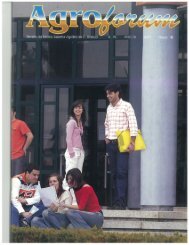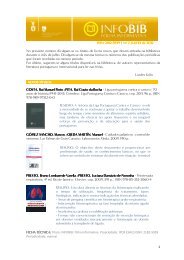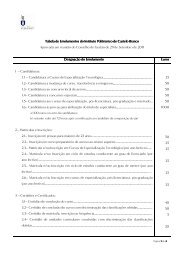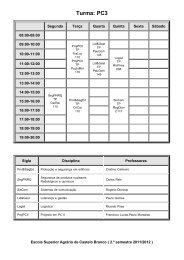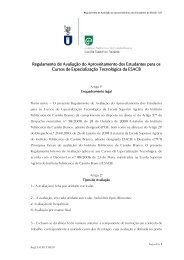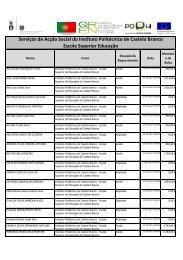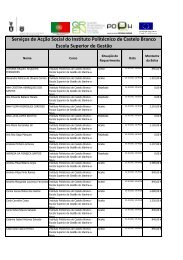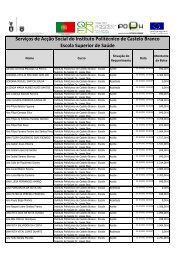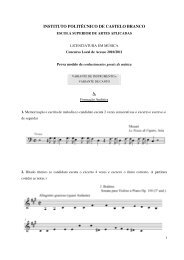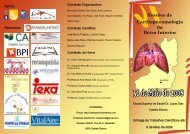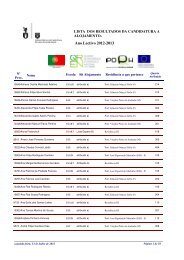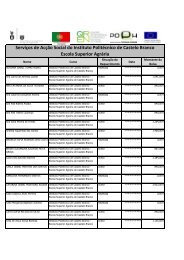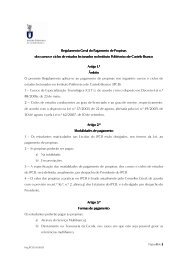N.º 24 - PDF - Instituto Politécnico de Castelo Branco
N.º 24 - PDF - Instituto Politécnico de Castelo Branco
N.º 24 - PDF - Instituto Politécnico de Castelo Branco
You also want an ePaper? Increase the reach of your titles
YUMPU automatically turns print PDFs into web optimized ePapers that Google loves.
4.3.3. Climate<br />
Climate conditions, for example, length of day, rainfall<br />
and field temperature, significantly influence the physical,<br />
chemical and biology qualities of MAP.<br />
4.3.4. Soil<br />
The soil should contain appropriate amounts of nutrients,<br />
organic matter and other elements to ensure optimal<br />
growth and quality. The use of fertilizers is often indispensable<br />
in or<strong>de</strong>r to obtain large yields of MAP. Animal manure<br />
should be thoroughly composted to meet safe sanitary<br />
standards of acceptable microbial limits and <strong>de</strong>stroyed by<br />
the germination capacity of weeds. Growers should implement<br />
practices that contribute to soil conservation and minimize<br />
erosion, for example, through the creation of streamsi<strong>de</strong><br />
buffer zones and the planting of cover crops and<br />
“green manure” such as alfalfa.<br />
4.3.5. Irrigation and drainage<br />
Irrigation and drainage should be controlled and carried<br />
out in accordance with the needs of the individual medicinal<br />
plant species during its various stages of growth.<br />
4.3.6. Plant maintenance and protection<br />
The timely application of measures such as topping, bud<br />
nipping, pruning and shading may be used to control the<br />
growth and the <strong>de</strong>velopment of the plant, thereby improving<br />
the quality and quantity of the medicinal being produced.<br />
Any agrochemicals used to promote the growth of or<br />
to protect MAP should be kept to a minimum, and applied<br />
only when alternative measures are available. Integrated<br />
pest management should be followed.<br />
5. Harvest<br />
MAPs should be harvested during optimal season or<br />
time period to ensure the production of the material and<br />
the finished herbal products of the best possible quality.<br />
The time of harvest <strong>de</strong>pends on the plant part used. It is<br />
well known that the concentration of biologically active<br />
constituents varies with the stage of the plant growth and<br />
<strong>de</strong>velopment.<br />
During harvest, care should be taken to ensure that no<br />
foreign matter, weeds or toxic plants are mixed with the<br />
harvest plant material.<br />
MAPs should be harvested un<strong>de</strong>r the best possible conditions,<br />
avoiding <strong>de</strong>w, rain or exceptionally high humidity.<br />
If harvesting occurs in wet conditions, the harvested material<br />
should be transported immediately to an indoor drying<br />
facility to expedite drying so as to prevent any possible<br />
<strong>de</strong>leterious effects due to increased moisture levels, witch<br />
promote microbial fermentation and mould.<br />
Cutting <strong>de</strong>vices, harvesters, and other machines should<br />
be kept clean and adjusted to reduce damage and contamination<br />
from soil and other materials.<br />
All containers used at harvest should be kept clean and<br />
free of contamination by previously harvested medicinal<br />
plants and other foreign matter. If plastic containers are used,<br />
particular attention should be paid to any possible retention<br />
of moisture that could lead to the growth of mould.<br />
6. Personnel<br />
Growers and producers should have a<strong>de</strong>quate knowledge<br />
of the medicinal plant concerned. This should inclu<strong>de</strong><br />
botanical i<strong>de</strong>ntification, cultivation characteristics and environmental<br />
requirements (soil type, soil pH, fertility, plant<br />
spacing and light requirements), as well as the means of<br />
harvest and storage.<br />
7. Post-harvesting processing<br />
Harvested or collected raw plant materials should be<br />
promptly unloa<strong>de</strong>d and unpacked upon arrival at the processing<br />
facility. Prior to processing, the medicinal plant materials<br />
should be protected from the rain, moisture and any<br />
other conditions that might cause <strong>de</strong>terioration. Medicinal<br />
plant materials should be exposed to direct sunlight only<br />
where there is s specific need for this mo<strong>de</strong> of drying.<br />
Medicinal or herb materials that are to be used in the<br />
fresh sate should be harvested/ collected and <strong>de</strong>livered as<br />
quickly as possible to the processing facility in or<strong>de</strong>r to<br />
prevent microbial fermentation and thermal <strong>de</strong>gradation.<br />
The materials may be stored un<strong>de</strong>r refrigeration, in jars, in<br />
sandboxes, or using enzymatic and other appropriate conservation<br />
measures immediately following harvest/collection<br />
and during transit to the end-user.<br />
8. Bulk packaging, storage and<br />
labelling<br />
Processed MAP materials should be packaged as quickly<br />
as possible to prevent <strong>de</strong>terioration. Continuous inprocess<br />
quality control measures shoul be implemented to<br />
eliminated substandard materials, contaminants and foreign<br />
matter prior to and during the final stage of packaging. In<br />
figure 2 we can see a great store of a producer.<br />
8<br />
n.º <strong>24</strong> Ano 18, 2010



